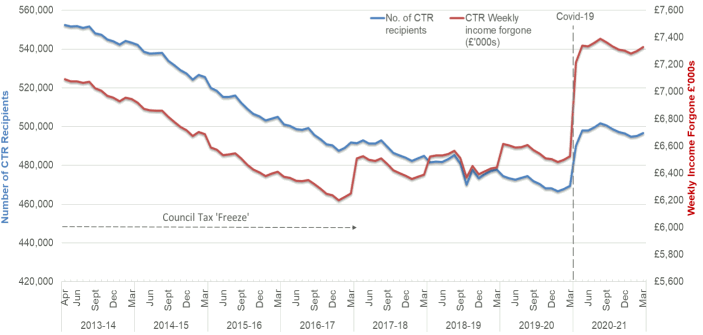Council Tax Reduction in Scotland, 2020-21
Council Tax Reduction (CTR) awarded by age, household structure, income sources and employment status, deprivation index, and Council Tax band in the financial year from April 2020 to March 2021. It also makes references to the previously published March 2020 statistics for comparative purposes.
Council Tax Reduction in Scotland, 2020-21
This publication provides statistics on the Council Tax Reduction (CTR) scheme, which reduces the Council Tax (CT) liability of lower income households in Scotland. A Council Tax Reduction ‘recipient’ can be a single person or a couple, with or without children, since Council Tax is charged on a per-dwelling basis, rather than to individuals.
The statistics are based on monthly data extracts from local authorities, and cover the time period April 2020 to March 2021. This publication therefore covers the period when the impacts of the Coronavirus (Covid-19) pandemic began to affect the CTR figures and will also make references to the previously published March 2020 statistics for comparative purposes.

Key Points
- There were 496,580 Council Tax Reduction recipients in Scotland in March 2021, an increase of 6 per cent from 469,370 in March 2020. These recipients live in one-fifth of the chargeable dwellings.
- From the introduction of the CTR scheme in April 2013, to March 2020 the number of Council Tax Reduction recipients in Scotland has gradually decreased. However there were large rises in caseload in 2020 due to the economic impact of Covid-19. The number of CTR recipients was only 10 per cent (55,800 recipients) lower in March 2021 than it was when the scheme began. Council Tax and Council Tax Reduction reforms, alongside increases in Council Tax since April 2017, have also resulted in increases in the total weekly Council Tax Reduction awarded.
- As shown in Chart 1, the total number of CTR recipients in Scotland increased sharply by 4.4 per cent in April 2020 to 490,160 from March 2020 (469,370), with further increases recorded in subsequent months as a result of the economic impacts of Covid-19. The largest increase in CTR recipients was observed in April and May 2020, as the economic effects of the Covid-19 pandemic began to be felt, with a peak of 501,680 CTR recipients in August 2020.
- The weekly income forgone by local authorities due to the Council Tax Reduction scheme was £7.328 million in March 2021, compared to £6.525 million in March 2020.
- The provisional income forgone on Council Tax Reduction in Scotland in 2020-21 was £374.9 million.
- Of all Council Tax Reduction recipients in March 2021:
- 57 per cent (282,220 recipients) were in one of the 30 per cent most deprived areas in Scotland compared to 58 per cent in March 2020;
- 34 per cent (169,540 recipients) were aged 65 or over compared to 37 per cent in March 2020; and
- 16 per cent (77,640 recipients) were lone parents, the same as in March 2020.
Changes in Council Tax and CTR changes since 1 April 2017
Chart 1 also shows the impact the following changes has had on the Council Tax Reduction scheme:
- The end of the Council Tax “freeze” which can be seen with the increase in Council Tax income forgone due to CTR in April annually since 2017;
- The introduction of Universal Credit (UC), the effects of which are described in Chart 15 in Section 3.1.
The figures reported in this publication should be viewed in light of the initial economic impacts of the Covid-19 pandemic. Some of the wider UK policy interventions introduced can be seen from the time line below. More information can be found at www.gov.scot/coronavirus-covid-19/.

Contact
Email: eddie.chan@gov.scot
There is a problem
Thanks for your feedback